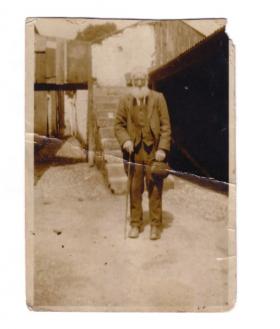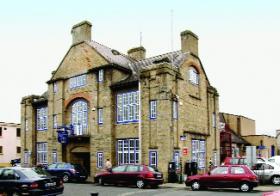Cavan’s forgotten contribution to the War of Independence
Published in 20th-century / Contemporary History, Issue 6 (Nov/Dec 2007), News, Revolutionary Period 1912-23, Volume 15
The author’s great-grandfather, Francis Melanaphy (c. 1923), at steps to the old granary/loft at the rear of Drumm’s, Ballyconnell, where parish arbitration courts were held. Plaintiffs were seen fist-fighting going in and shaking hands coming out.
Nineteen-sixteen is looked on as a pivotal year in Irish history, but 1917, with the rapid growth of political Sinn Féin, was the year when the democratic foundations of nationhood were established. Sinn Féin won by-elections with Count Plunkett in Roscommon, McGuinness in Longford and de Valera in Clare. These political victories led to the rapid growth of Sinn Féin clubs throughout the non-Unionist parts of Ireland. In early 1917 there were only four clubs in County Cavan but this grew to 53 with 2,623 members by the year’s end, contributing much to Arthur Griffith’s winning of the East Cavan by-election that November.
At a joint meeting of East and West Cavan Sinn Féin (representing 32 clubs) at Cavan Town Hall on Sunday 30 September 1917, with County Council chairman Mr Philip Baxter presiding, the following resolution (proposed by T. L. O’Brien, Lavey, and seconded by J. Lynch, Carrickallen) was adopted:
‘That the joint executives of East and West Cavan Sinn Féin clubs hereby formulate a Board of Arbitration whose function shall be to amicably settle all disputes between members in all matters of either finance, property or person: to put the scheme on a working basis it is proposed to appoint in each parish, three reliable and trusted arbitrators (one of whom can be the parish priest or curate, the others two members or officers of the club) to whom all disputes shall be referred; that the several executives shall appoint three members each as appeal courts to whom any aggrieved party may appeal and that the findings of the Parish Board or Executive Appeal Court shall have the entire force of the Sinn Féin movement, financially or otherwise, to reinforce the awards; that the executive of each county in Ireland be furnished with a copy of this resolution in order to do likewise, and thereby deny law costs to the Crown or any traffic at all avoidable in English courts.’
The motion was later ratified by Sinn Féin’s national council and became part of the party’s constitution.
This motion, while recognised as the intellectual property of the proposer and seconder, had to be guided by a political hand. It may have been written and/or directed by Seán Milroy (when not imprisoned), a member of Sinn Féin’s national council and an organiser in County Cavan. Milroy, a native of Belfast, was a close confidant of Arthur Griffith and later a TD for Cavan. Along with Éamon de Valera and Seán McGarry, Milroy was later sprung from Lincoln Jail by Michael Collins and Harry Boland on the night of 3 February 1919.
The arbitrators appointed were respected and often self-taught men of integrity (there is no evidence of women appointed in County Cavan) who undertook their roles as citizens on the principles of equality and fairness for their communities. In these courts, Roman or Brehon laws could be quoted but not that of ‘the realm’. The following extracts are taken from Sinn Féin clubs’ notices in the Anglo-Celt of 27 October 1917:
‘(a) West Cavan Executive notes—and general discussion on the order that clubs take immediate action to appoint arbitration boards, at the conclusion of, Mr. T. Smith Co. C said “the proposer of the scheme informed him that already a very serious dispute had been settled by arbitration on these lines”.
(b) Swanlinbar notes—At a meeting on Sunday Mr. P. McGovern, chairman presiding, an arbitration tribunal was established . . .’
And from the Anglo-Celt of 15 December 1917:
‘(a) Kingscourt—At fortnightly meeting in St Mary’s Hall on Sunday, Mr F. O’Brien presiding, the arbitration committee reported that a settlement satisfactory to both parties had been made in an agrarian dispute . . .
(b) Ballyconnell—At a largely attended meeting Mr E. Shannon presiding, a board of arbitration was appointed. However, at this meeting the chairman urged the importance of dealing with the food problem at once, in view of the danger of famine next spring if food stuffs were allowed to be exported.’
These courts were modelled on the British petty sessions but with three lay arbitrators rather than a resident magistrate (RM) or justice of the peace (JP) sitting.

Cavan Town Hall, where Dáil Courts met from July 1920
Defendants and plaintiffs were allowed legal representation or a ‘citizen advocate’. There are very limited reports on the workings of the parish arbitration courts prior to the setting up of the ‘Dáil Courts’ in June 1920. Proceedings were held in private and sometimes in the open air, away from public view. It was related to me by my late mother that many courts in Ballyconnell were held in an old granary or loft at her home, where as a child she saw people ‘fist fighting’ going into court and ‘shaking hands’ coming out. The courts were used by many Protestant families, she maintained, to resolve land disputes and the more intricate family problems of ‘entailed wills’. The arbitration courts dealt with complex land issues and were practical to use as costs were very low. The public reporting of the establishment of parish boards of arbitration was a challenge to the British administration and a signal to the Irish people and the legal profession to commence disengagement from the British courts system in Ireland. The authorities were aware of these illegal courts but, since they were dealing with sometimes intractable agrarian disputes, they assumed (hoped?) that they would collapse and discredit the Sinn Féin movement.
The first press report on the proceedings of a Dáil Court (from Ballyconnell) was in the Anglo-Celt on 7 July 1920; the second was from the Town Hall, Cavan. This court sat on 10 July, the same day that the petty sessions were suspended in the courthouse. Cases were outlined, with plaintiffs, defendants and legal representatives named. Since the reported proceedings happened literally within days of the Dáil Courts being set up, it is reasonable to deduce that parish or arbitration courts were already well established in County Cavan. And many more Dáil Court cases were subsequently reported in the Anglo-Celt.
In County Monaghan, on the other hand, the Dáil Courts system had to be established from scratch. On 24 July 1920 the Anglo-Celt reported that ‘. . . Arbitrators for Republican Courts, Parish and District in North Monaghan were selected at a convention held in Monaghan by direction of the Dáil Éireann Minister for Home Affairs. O. O’Duffy acted as secretary.’ A similar convention was held in Castleblayney for South Monaghan. There is no evidence of any such convention being called or held in County Cavan.
According to Lord Longford in his Peace by ordeal (1935):
‘By July 1920 there were few places outside Dublin and North-East Ulster where the King’s writ continued to run. And testimony in favour of the new courts was astonishingly general. Lord Montegal praised them, the Chicago Tribune praised them, the Manchester Guardian and the Daily News praised them, the Daily Mail praised them; even the Irish Times had no complaint to make of them, and plenty of fun to poke at their supplanted rivals. The commission appointed by the Society of Friends reported: “Moderate people and many Unionists admit the only protection they enjoy is provided by Sinn Féin police”. By this time the republican administration possessed, as Bonar Law admitted, “all the symbols and all the realities of a Government”.’
During the Treaty talks in London, the fact that the Dáil Courts were sitting openly was an irritant to the British side as it appeared to anticipate the concession of a republic. Lloyd George showed disquiet that a court in Dublin had been declared open ‘in the name of the Irish Republic’, and told his colleagues (13 October 1921) that ‘I shall have to tell the Irish that we shall have to scatter these courts’. When the matter was raised with Griffith and Collins, assurances were given that something would be done. Clearly Dáil Courts, now sitting throughout most of Ireland, were working and were hurting the British establishment.
The successful arbitration and subsequent Dáil Courts laid the foundations for the new Irish state. The self-imposed discipline that these courts gave the Irish people, in spite of their later suppression, must have influenced our short-lived civil war and enhanced the ability of our fledgling state to form the unarmed Garda Síochána in the middle of it.
Dermot McMonagle is a local historian.
















